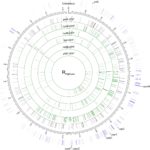 A new study led by researchers at the Department of Energy’s Joint BioEnergy Institute (JBEI), based at Lawrence Berkeley National Laboratory (Berkeley Lab), demonstrates the importance of microbial communities as a source of stable enzymes that could be used to convert plants to biofuels. The study, recently published in the journal Nature Microbiology, reports on the discovery of new types of cellulases, enzymes that help break down plants into ingredients that can be used to make biofuels and bioproducts. The cellulases were cultured from a microbiome. Using a microbial community veers from the approach typically taken of using isolated organisms to obtain enzymes. Read more in the Berkeley Lab’s News Center.
A new study led by researchers at the Department of Energy’s Joint BioEnergy Institute (JBEI), based at Lawrence Berkeley National Laboratory (Berkeley Lab), demonstrates the importance of microbial communities as a source of stable enzymes that could be used to convert plants to biofuels. The study, recently published in the journal Nature Microbiology, reports on the discovery of new types of cellulases, enzymes that help break down plants into ingredients that can be used to make biofuels and bioproducts. The cellulases were cultured from a microbiome. Using a microbial community veers from the approach typically taken of using isolated organisms to obtain enzymes. Read more in the Berkeley Lab’s News Center.
A Smartphone-based Microscope for Treating River Blindness
LoaScope, the latest iteration of the CellScope technology developed in the lab of Daniel Fletcher, turns the camera of a mobile device into a microscope and automatically detects and quantifies infection by parasitic worms in a drop of blood. One such parasite, Onchocerca volvulus, is endemic to Africa and can lead to blindness in infected individuals. Treatment with the drug ivermectin is complicated because co-infection by another parasitic worm, the Loa loa, can cause fatal side effects. Expanding on a successful pilot study, the LoaScope was used to analyze the blood of patients in Cameroon, enabling doctors to treat more than 15,000 people with ivermectin without serious complications. Fletcher, a faculty scientist in Biological Systems and Engineering (BSE) and chair of the UC Berkeley Department of Bioengineering, is a coauthor on the report published in the New England Journal of Medicine. Read more from UC Berkeley News.
JBEI Researchers Improve Membrane Protein Expression And Function Using Genomic Edits
 Development of robust microbial platforms for bioproduction requires strains that have been engineered to have efficient carbon uptake, energy generation, tolerance to biomass pretreatment byproducts and the export of final product. Many of these optimizations require expression and overexpression of native and heterologous membrane proteins. Over the years, scientists at the U.S. Department of Energy’s Joint BioEnergy Institute (JBEI), and others have successfully found many such engineering targets. However, JBEI has also found that expression of membrane proteins is challenging and can also impact the microbial growth, thus negatively limiting the use of these discoveries. Read more from JBEI.
Development of robust microbial platforms for bioproduction requires strains that have been engineered to have efficient carbon uptake, energy generation, tolerance to biomass pretreatment byproducts and the export of final product. Many of these optimizations require expression and overexpression of native and heterologous membrane proteins. Over the years, scientists at the U.S. Department of Energy’s Joint BioEnergy Institute (JBEI), and others have successfully found many such engineering targets. However, JBEI has also found that expression of membrane proteins is challenging and can also impact the microbial growth, thus negatively limiting the use of these discoveries. Read more from JBEI.
Screening for Disease or Toxins in a Drop of Blood
A Berkeley Lab spin-out, Newomics is creating blood-based assays for diabetes diagnosis and management, and for the monitoring of environmental toxins, among other health care applications. The core technology, a multi-nozzle emitter array (MEA) for mass spectrometry, was developed by Newomics founder and president Daojing Wang, a guest scientist in Biological Systems and Engineering (BSE), while he was in the Lab’s Life Sciences Division (now part of the Biosciences Area). Collaborators on the emitter technology included Pan Mao, formerly in Life Sciences, and Peidong Yang in the Materials Sciences Division. Read more in the Berkeley Lab News Center.
ABPDU a Catalyst for Broader Bio-based Economy
Five years in, the Advanced Biofuels Process Development Unit has established more than 30 diverse partnerships
 The original scope of the Advanced Biofuels Process Development Unit (ABPDU) was to tackle the barriers to biofuel commercialization. Five years in, its activities have expanded to utilize a broader range of raw materials to produce a variety of bio-based material, chemical, and protein end products. To date, the ABPDU has entered into agreements with more than 30 partners from other national labs, government agencies, industry, and academia. In this article the ABPDU’s partners talk about how this unique facility has supported them in scaling up their processes, and reaching their business goals.
The original scope of the Advanced Biofuels Process Development Unit (ABPDU) was to tackle the barriers to biofuel commercialization. Five years in, its activities have expanded to utilize a broader range of raw materials to produce a variety of bio-based material, chemical, and protein end products. To date, the ABPDU has entered into agreements with more than 30 partners from other national labs, government agencies, industry, and academia. In this article the ABPDU’s partners talk about how this unique facility has supported them in scaling up their processes, and reaching their business goals.
- « Previous Page
- 1
- …
- 33
- 34
- 35
- 36
- 37
- …
- 62
- Next Page »
Was this page useful?







